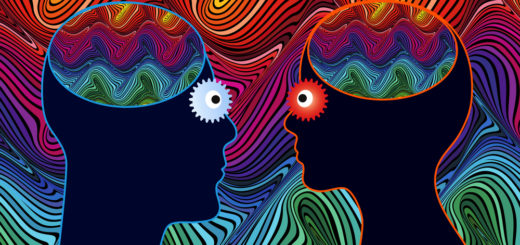Immersive reality: history and current state of affairs
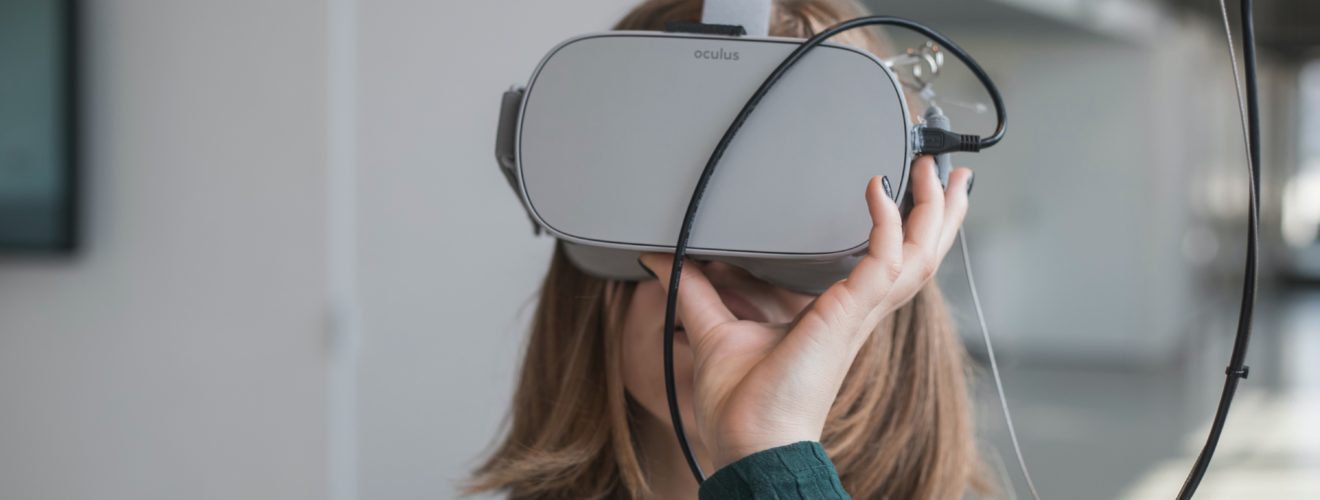
Virtual reality (VR) systems are a sophisticated interplay of technology and human perception. However, it has not always been this way; it started with a simple stereoscope. In 1838, Charles Wheatstone discovered that different two-dimensional images presented in each eye are processed slightly different and form a single three-dimensional object. This led to the invention of the stereoscope. Today, Google Cardboard utilises the same principles as the very first stereoscope.
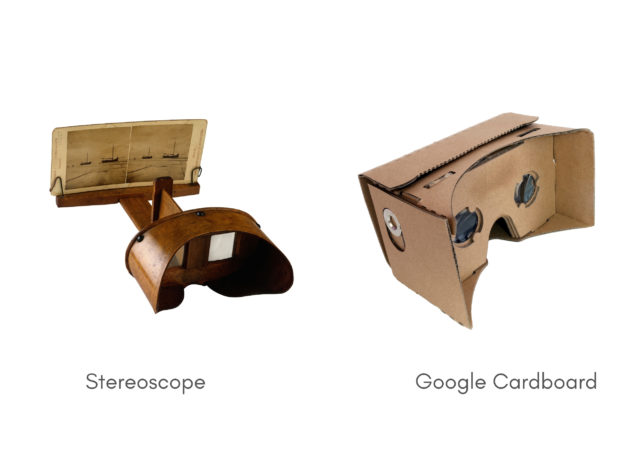
With the arrival of new technological development in the 20th century, the concept of VR has become a reality and more advanced systems were starting to emerge. Expectedly, the majority of work on VR came from the air force and military. In 1929, Edward Link built the first flight simulator, which was electromechanical and mimicked real flight experience. A year later, Stanley G. Weinbaum wrote a piece of science fiction titled Pygmalion’s spectacles which predicted what VR eventually was going to become. The story described a pair of glasses, which let you experience a fictional world through all of your senses. Furthermore, in 1960, Morton Heilig patented a Telesphere Mask. Although it lacked technological sophistication, it is incredibly similar to our current VR headsets. Two years later, Heilig made another contribution to the development of VR. He patented Sensorama, which was a small cabinet designed to create a virtual world that stimulates all human senses. It used vibrating chairs, various smells, sounds, fans, and a stereoscopic display for a three-dimensional view of the world. In 1965, Ivan Sutherland described VR as:
“The ultimate display would, of course, be a room within which the computer can control the existence of matter. A chair displayed in such a room would be good enough to sit in. Handcuffs displayed in such a room would be confining, and a bullet displayed in such a room would be fatal. With appropriate programming such a display could literally be the Wonderland into which Alice walked.” (Sutherland, 1965)
In 1968, Sutherland created the first head-mounted display—The Sword of Damocles. Images displayed were simple wireframe rooms. Head tracking was necessary and was accomplished by attaching wires, hanging from the ceiling, to the headset itself. Soon after, during the 1970s–1990s VR research was dominated by military research: predominantly via NASA and British Aerospace.
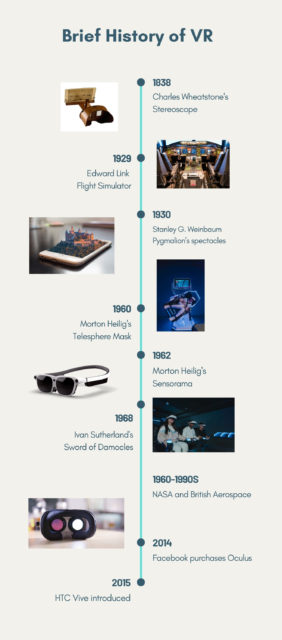
Research and work in VR stalled in the late 1990s and early 2000s, but it picked up again when Oculus Rift, a start-up company, was purchased by Facebook in 2014. Oculus Rift developed an affordable headset that had all the specifications required for full VR immersion. In 2015, the HTC Vive headset was introduced, and there has been a great increase in VR research ever since.
Definitions
VR is as difficult to define as the experience itself. Merriam-Webster dictionary defines VR as “an artificial environment experienced through sensory stimuli, such as sights and sounds, provided by a computer, in which one’s actions partially determine what happens in the environment.” However, general understanding of VR is narrower and often refers to an artificial environment experienced through a variety of senses, which is created by a computer and accessed via a display, often a Head-Mounted Display (HMD). An HMD is a pair of large glasses strapped onto the head, it displays a virtual environment using two different images, one projected to each eye, creating the compelling illusion of a three-dimensional scene all around them. Alongside state-of-the-art graphics, a VR system usually incorporates one or more input devices (for example, controllers, gloves or motion trackers). VR system capabilities vary greatly depending on the capacity of the device and the quality of the three-dimensional world built by it. However, all VR systems share three main features: immersion, interaction, and a sense of presence. The immersion feature refers to how well the system isolates the user from reality and is inherently linked to hardware capabilities. The interaction feature allows the user to interact with objects within the virtual environment in real-time. The sense of presence feature is a consequence of both immersion and interaction features; it is the psychological feeling of being present in the virtual environment despite the awareness of not actually being there. These features combine to provide highly immersive environments and safe, but realistic, scenarios.
Current Applications
Entertainment has been one of the first fields to adopt VR: where particularly the gaming industry has been the driving force for VR research over the past few decades. It has produced some amazing graphics which can now be used in other fields. Additionally, there has been an increased interest in VR cinema; however, the logistic challenges have not been overcome yet. Regardless, there are a small number of short films resembling VR games, but they are still limited when it comes to user interaction. VR has also been actively used by museums where you can enter the museum remotely1 or you can experience the historical setting of the displays.
VR in education provides new teaching and learning tools for the exploration of objects, textures, safe spaces and environments that we normally could not attend, especially in cases of adult training, for example, construction work or architecture training.2
Using this technique, teachers can provide an exciting new learning environment for pupils and help them better retain information. Some tools used in teaching, like web conferences, can easily transfer to other fields, such as business or politics. Although there are some challenges in VR use for education that require further research. One of those challenges is addressing how safe VR is for younger children.
University of Glasgow has partnered with Edify3 to find out how students in higher education learn in the virtual world.4
During this era of remote working and learning, Edify has established a novel concept of VR-by-Proxy., where teachers can create a lesson in VR and broadcast it in real-time using standard conferencing tools, such as Zoom or Microsoft Teams.
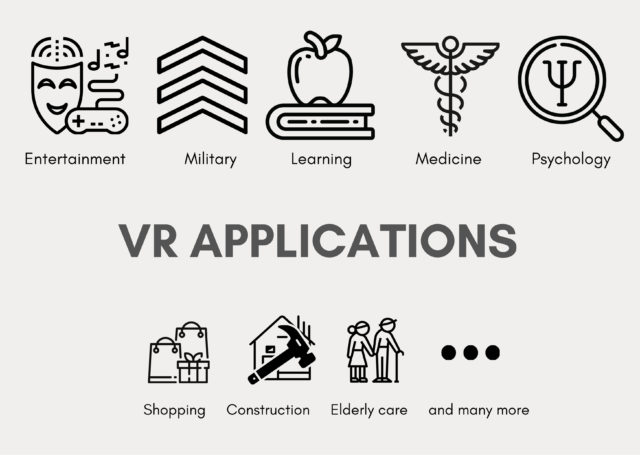
VR has been used in military and aerospace extensively and has spread out over various applications in these fields. Combat training is one of the most common uses of VR in the military, as it provides a safe training environment and multiple simulation scenarios. Caballero and Niguidula, in 20185 described a disaster risk management and emergency preparedness software developed for VR. The software simulates a variety of emergency situations and offers a selection of guidelines on how to proceed. Stress management is another important application of VR: it enables soldiers to learn resilience and empowerment. However, if such preparations still fail, VR has been extensively used for the treatment of Post Traumatic Stress Disorder (PTSD). Albert Rizzo and colleagues, in 20156, introduced a Virtual Reality Exposure (VRE) system, which simulates virtual scenarios of the Iraq or Afghanistan wars and World Trade Centre destruction. The VRE system can be used for safe exposure and treatment of PTSD.
Medicine is another field where VR has been used more recently. In 2016, Andrea Chirico’s team7 described a system in which distractions during painful procedures help cancer patients deal with the pain. A similar distraction technique has been used for children that were afraid of injections. A simulated game places the pain of the needle piercing the skin in a different context and this reduces children’s fear of the procedure. Furthermore, VR has been used in the rehabilitation of stroke patients, helping them overcome challenging motor and precision tasks.8
Although VR presents a lot of exciting opportunities, the ethics surrounding its use are still debated, particularly in the field of medicine.
Psychology has adopted VR only fairly recently for the management of emotions, addressing fear of public speaking and treatment of a broad range of mental health problems.9 These applications have recently sparked interest in the field of visual perception and it promises more research in the area.
There is a broad range of other applications for VR technology. Hyoung Seok Kang et al., in 201510 listed VR applications in manufacturing industries. In 2017, Shuchisnigdha Deb et al.11 explained the efficacy of VR in pedestrian safety research, and Martin Meißner et al.13
It is unclear where we will be in the next year, let alone in another 10 years. One thing is certain, immersive technology is rapidly becoming a household name and will soon find its place just like laptops and smartphones that came before it.
This article was specialist edited by Ioannis John Vourganas and copy-edited by Mais Al-Attili
References
- https://link.springer.com/chapter/10.1007/978-3-319-28231-2_45
- https://viejournal.springeropen.com/articles/10.1186/s40327-015-0031-5
- https://edify.ac/
- https://www.gla.ac.uk/research/az/cspe/projects/vrar/projectmobius/
- https://dl.acm.org/doi/abs/10.1145/3205946.3205950
- https://link.springer.com/article/10.1007/s10879-015-9306-3
- https://onlinelibrary.wiley.com/doi/abs/10.1002/jcp.25117
- https://bmcmedinformdecismak.biomedcentral.com/articles/10.1186/s12911-016-0377-1
- https://www.tandfonline.com/doi/abs/10.1080/03069880902957056
- https://link.springer.com/article/10.1007%2Fs40684-016-0015-5
- https://www.sciencedirect.com/science/article/abs/pii/S0968090X17302383
- discussed how VR can be used to enhance shoppers’ experience. There has also been some interest in using VR to aid with care for the elderly.
The world of immersive technology is evolving rapidly. Alongside VR, we currently have Augmented Reality (AR), Mixed Reality (MR) and the all-encompassing term—Extended Reality (XR). Development of VR headsets is leaping forward too. The new Oculus Quest 2 is a pair of standalone glasses with two controllers, all of which you can purchase now within a consumer budget.12https://www.oculus.com/quest-2



